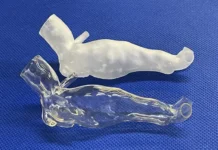by R.W. Stowe, UV Applications Engineering Consultant, Heraeus Noblelight America LLC
Life in the UV curing world was easier when UV lamps only stretched across a web or flat conveyor, and all we had to worry about was width, number of rows and distance from the work. But, as we move into 3D processing of complex shaped objects, lamps are located all over the curing zone. In fixed-lamp 3D configurations, each lamp has its own optimized position. Setting lamps in a large 3D installation falls somewhere between science and art.
Chain-on-edge systems and paint lines represent a whole family of problems in orienting the UV lamps. The line can be continually moving or intermittent. The parts can be rotating or not. The solutions to lamp positioning to provide uniform exposure to all (or most) of the surfaces can be quite complex. But, let’s stick to the question of describing lamp orientation.
Have you ever tried to describe the orientation of a UV lamp – or several lamps – in a 3D configuration? Have you watched an otherwise conservative engineer waving his hands and arms, often with the assistance of pens (to represent bulbs) and file cards (curved, to represent reflectors), trying to communicate the orientation of a lamp in space? What about changing the position of a lamp? Does it drive you nuts to hear the description of “Just rotate the lamp a little?” “Rotate? What does THAT mean?” “You know … tilt it … at an angle.” Uh-oh.
Some time ago, it struck me that describing how to orient something in space isn’t a new problem. There is a language that is clear and that we can adapt easily to 3D lamp orientation. It’s used all the time in flight and aerospace situations. There are two parts: attitude and position.
Attitude
Think airplane. We begin with pitch, yaw and roll. For the pilot of an airplane, pitch is the angle relative to a plane, for example, the horizon: nose up, nose down or level. Yaw is turning right or left. Roll is raising one wing and lowering the other. These three axes will completely describe the attitude of the aircraft.
Think of the axis of the UV bulb aligned with the wingspan of the aircraft, and you get the idea.
Position
This is a little trickier because there are several ways to locate a point in space. First, the principal axis is along the direction of travel of the production line. The principal axis can be located anywhere parallel to the travel. The centerline of the conveyor and the floor, for example, are convenient reference points for locating the principal axis.
Imagine a horizontal plane through this principal axis. This is like the horizon. A point can be located by its height (altitude) from the plane and its horizontal distance from the centerline (Cartesian coordinates). Another way to locate the point is to use its angle of elevation from the “horizon” plane and the distance to the principal axis. Pick one of these ways and stick with it.
By locating the position of a point in space and describing the attitude of the object at that point, its precise orientation can be described and communicated – or drawn – consistently. And this method of description is independent of the complexities of object shapes and surfaces to be cured. (How many and where to locate lamps for maximum effectiveness is a topic for another day.)
Now, if this doesn’t make it easier, maybe some pencils and some file cards …







